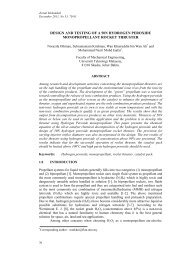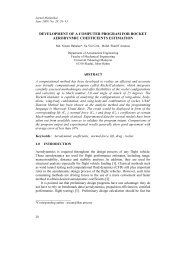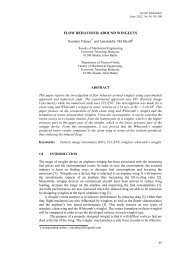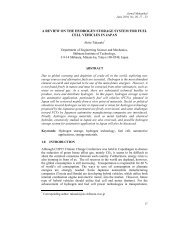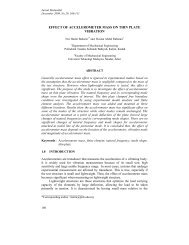Investigation of Gas Swirl Burner Characteristic ... - Jurnal Mekanikal
Investigation of Gas Swirl Burner Characteristic ... - Jurnal Mekanikal
Investigation of Gas Swirl Burner Characteristic ... - Jurnal Mekanikal
Create successful ePaper yourself
Turn your PDF publications into a flip-book with our unique Google optimized e-Paper software.
<strong>Jurnal</strong> <strong>Mekanikal</strong> December 2011high-swirl type <strong>of</strong> burner in which the swirling motion generated by the injector (orburner) is sufficiently high to produce a fully developed internal recirculation zone at theentrance <strong>of</strong> the combustor. For conventional non-premixed combustion, the role <strong>of</strong> thelarge recirculation zone, also known as the toroidal vortex core, is to promote turbulentmixing <strong>of</strong> fuel and air. In premixed systems, the recirculation zone provides a stable heatsource for continuous ignition <strong>of</strong> the fresh reactants, as refers to the review <strong>of</strong> Syred et.al. [7] for extensive background on the basic processes and practical implementation <strong>of</strong>high-swirl combustors.But according <strong>of</strong> some study <strong>of</strong> Pleasing et. al. [8] and Shepherd [9] low-swirlcombustion is a relatively recent development, is an excellent tool for laboratory researchon flame/turbulent interactions. Its operating principle exploits the “propagating wave”nature <strong>of</strong> premixed flames and is not valid for non-premixed combustion. Premixedflames consume the reactants in the form <strong>of</strong> self-sustained reacting waves that propagateat flame speeds controlled by mixture compositions, thermodynamic conditions, andturbulence intensities. In contrast, non-premixed diffusion flames do not propagate (i.e.,move through the reactants) because burning occurs only at the mixing zones <strong>of</strong> the fueland oxidizer streams. To capture a fast moving turbulent premixed flame as a “standingwave” that remains stationary, low-swirl combustion exploits a fluid mechanicalphenomenon called a divergent flow. As the name implies, divergent flow is anexpanding flow stream. It is formed when the swirl intensities are deliberately low suchthat vortex breakdown, a precursor to the formation <strong>of</strong> flow reversal and recirculation,does not occur. Therefore, the Low <strong>Swirl</strong> Combustion (LSC principle is fundamentallydifferent from the high-swirl concept <strong>of</strong> typical Dry Low NO x (DLN) gas turbines, wherestrong toroidal vortexes are the essential flow elements to maintain and continuouslyreignite the flames. The engineering guideline for the LSB is specified in terms <strong>of</strong> a range<strong>of</strong> swirl number (0.4 < S < 0.55),As part <strong>of</strong> this study, producer gas, a mixture <strong>of</strong> gases from the biomassgasification process that is capable <strong>of</strong> burning fuel and gas, was used. The number <strong>of</strong>elements in producer gas depends on the type <strong>of</strong> biomass and operational conditions. Forexample, CO, H 2 , and CH 4 can be utilized, while N 2 , CO 2 , tar and ash cannot be directlyutilized, Bridgwater [10]. Since quality <strong>of</strong> the gas mixture is unknown at the beginning <strong>of</strong>the gasification process, a tool used to determine the parameters <strong>of</strong> the quality <strong>of</strong> themixing method is Computational Fluid Dynamics (CFD), which provides an analysis <strong>of</strong>the fluid flow in the system using numerical algorithms.The swirl flow effect has usually been used for the combustion and processing <strong>of</strong>materials that are normally considered difficult to burn or process efficiently, such asvegetable refuse, high ash content coals, anthracite, high sulfur oils, and waste gases withlow calorific values. Air and fuel are introduced tangentially at one end and combustiontakes place, primarily near the walls as swirling flow along the chamber towards theexhaust at the other end, Brunner et. al. [11]. A high shear and high property gradientsexist in the high turbulence zone at the interface between the jets <strong>of</strong> fuel and air. And onthe time produces flame combustion with high heat release rates. The main characteristics<strong>of</strong> swirl flow are:• long residence times, which depend upon swirl number and chamber length• a long, thin annular recirculation zone formed internally close to the walls that can beused to enhance flame stabilization• ability to adapt in a two-stage combustor arrangement, with the swirl burner typeflow in the exit being used to provide an afterburning process which ensures completefuel burnout• reduction in combustion chamber size by producing higher rates <strong>of</strong> entrainment <strong>of</strong> theambient fluid and fast mixing near the exit nozzle.16



